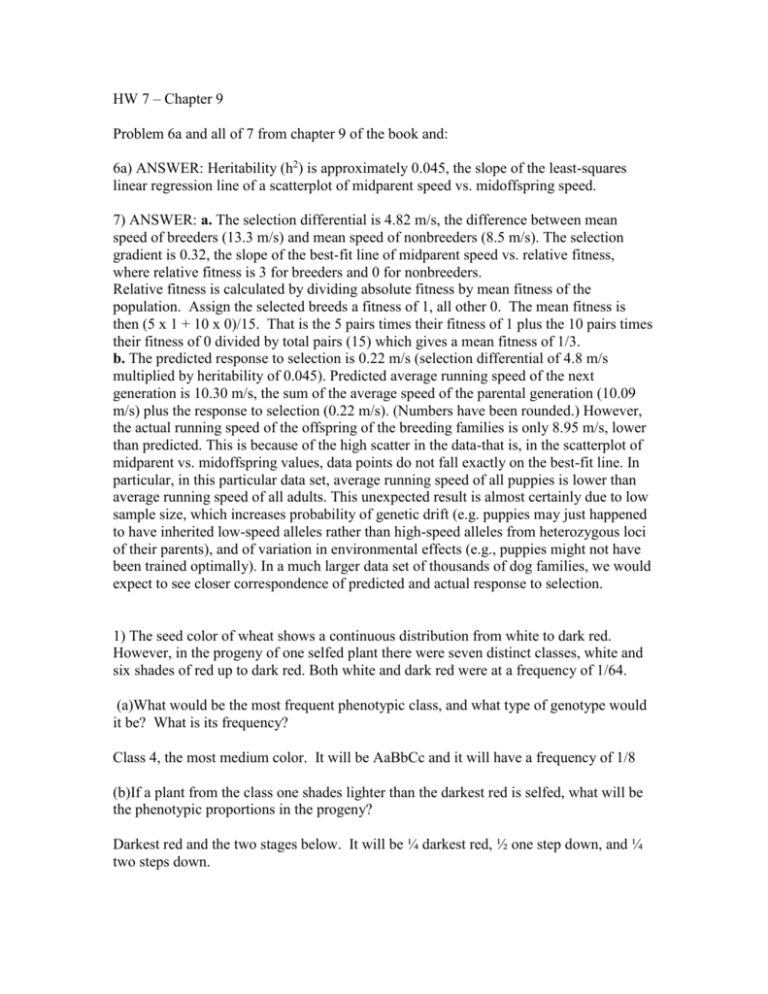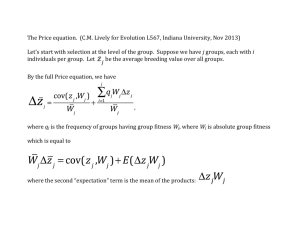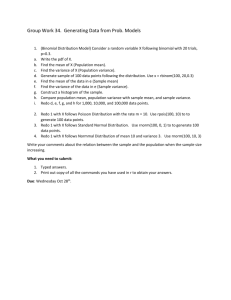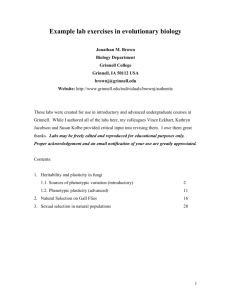HW 7 key
advertisement

HW 7 – Chapter 9 Problem 6a and all of 7 from chapter 9 of the book and: 6a) ANSWER: Heritability (h2) is approximately 0.045, the slope of the least-squares linear regression line of a scatterplot of midparent speed vs. midoffspring speed. 7) ANSWER: a. The selection differential is 4.82 m/s, the difference between mean speed of breeders (13.3 m/s) and mean speed of nonbreeders (8.5 m/s). The selection gradient is 0.32, the slope of the best-fit line of midparent speed vs. relative fitness, where relative fitness is 3 for breeders and 0 for nonbreeders. Relative fitness is calculated by dividing absolute fitness by mean fitness of the population. Assign the selected breeds a fitness of 1, all other 0. The mean fitness is then (5 x 1 + 10 x 0)/15. That is the 5 pairs times their fitness of 1 plus the 10 pairs times their fitness of 0 divided by total pairs (15) which gives a mean fitness of 1/3. b. The predicted response to selection is 0.22 m/s (selection differential of 4.8 m/s multiplied by heritability of 0.045). Predicted average running speed of the next generation is 10.30 m/s, the sum of the average speed of the parental generation (10.09 m/s) plus the response to selection (0.22 m/s). (Numbers have been rounded.) However, the actual running speed of the offspring of the breeding families is only 8.95 m/s, lower than predicted. This is because of the high scatter in the data-that is, in the scatterplot of midparent vs. midoffspring values, data points do not fall exactly on the best-fit line. In particular, in this particular data set, average running speed of all puppies is lower than average running speed of all adults. This unexpected result is almost certainly due to low sample size, which increases probability of genetic drift (e.g. puppies may just happened to have inherited low-speed alleles rather than high-speed alleles from heterozygous loci of their parents), and of variation in environmental effects (e.g., puppies might not have been trained optimally). In a much larger data set of thousands of dog families, we would expect to see closer correspondence of predicted and actual response to selection. 1) The seed color of wheat shows a continuous distribution from white to dark red. However, in the progeny of one selfed plant there were seven distinct classes, white and six shades of red up to dark red. Both white and dark red were at a frequency of 1/64. (a)What would be the most frequent phenotypic class, and what type of genotype would it be? What is its frequency? Class 4, the most medium color. It will be AaBbCc and it will have a frequency of 1/8 (b)If a plant from the class one shades lighter than the darkest red is selfed, what will be the phenotypic proportions in the progeny? Darkest red and the two stages below. It will be ¼ darkest red, ½ one step down, and ¼ two steps down. 2) In a population of beetles the total variance of body weight was 130. It was estimated that the environmental variance was 35, and dominance genetic variance was 45. From these data calculate heritability in the narrow sense. Narrow sense heritability is defined as additive genetic variance divided by phenotypic variance (VA/VP). Phenotypic variance is equal to the additive variance plus the dominance variance plus the environmental variance (VP = VA + VD + VE). The total variance is the phenotypic variance (130). If the dominance is 45 and the environmental is 35, then you can calculate the additive variance (130 = VA + 45 + 35, VA =130 – (45 +35) = 50). Once we know the additive variance then we can calculate narrow sense heritability as above (50/130 = 0.39).









